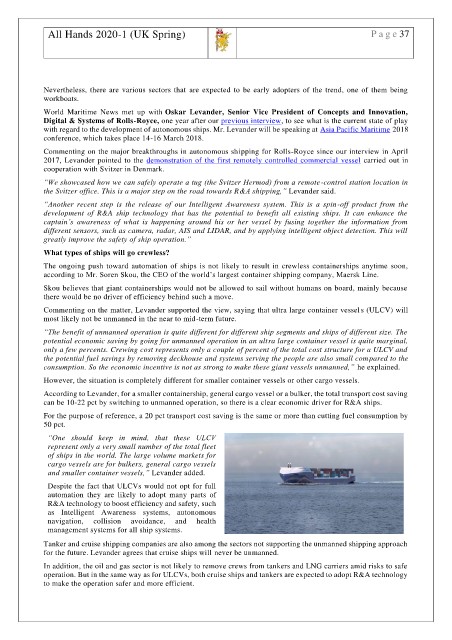Page 39 - D:\AA Warsash Association\Journals\2020\AH2020-1\DEK\
P. 39
All Hands 2020-1 (UK Spring) P a g e 37
Nevertheless, there are various sectors that are expected to be early adopters of the trend, one of them being
workboats.
World Maritime News met up with Oskar Levander, Senior Vice President of Concepts and Innovation,
Digital & Systems of Rolls-Royce, one year after our previous interview, to see what is the current state of play
with regard to the development of autonomous ships. Mr. Levander will be speaking at Asia Pacific Maritime 2018
conference, which takes place 14-16 March 2018.
Commenting on the major breakthroughs in autonomous shipping for Rolls-Royce since our interview in April
2017, Levander pointed to the demonstration of the first remotely controlled commercial vessel carried out in
cooperation with Svitzer in Denmark.
“We showcased how we can safely operate a tug (the Svitzer Hermod) from a remote-control station location in
the Svitzer office. This is a major step on the road towards R&A shipping,” Levander said.
“Another recent step is the release of our Intelligent Awareness system. This is a spin-off product from the
development of R&A ship technology that has the potential to benefit all existing ships. It can enhance the
captain’s awareness of what is happening around his or her vessel by fusing together the information from
different sensors, such as camera, radar, AIS and LIDAR, and by applying intelligent object detection. This will
greatly improve the safety of ship operation.”
What types of ships will go crewless?
The ongoing push toward automation of ships is not likely to result in crewless containerships anytime soon,
according to Mr. Soren Skou, the CEO of the world’s largest container shipping company, Maersk Line.
Skou believes that giant containerships would not be allowed to sail without humans on board, mainly because
there would be no driver of efficiency behind such a move.
Commenting on the matter, Levander supported the view, saying that ultra large container vessels (ULCV) will
most likely not be unmanned in the near to mid-term future.
“The benefit of unmanned operation is quite different for different ship segments and ships of different size. The
potential economic saving by going for unmanned operation in an ultra large container vessel is quite marginal,
only a few percents. Crewing cost represents only a couple of percent of the total cost structure for a ULCV and
the potential fuel savings by removing deckhouse and systems serving the people are also small compared to the
consumption. So the economic incentive is not as strong to make these giant vessels unmanned,” he explained.
However, the situation is completely different for smaller container vessels or other cargo vessels.
According to Levander, for a smaller containership, general cargo vessel or a bulker, the total transport cost saving
can be 10-22 pct by switching to unmanned operation, so there is a clear economic driver for R&A ships.
For the purpose of reference, a 20 pct transport cost saving is the same or more than cutting fuel consumption by
50 pct.
“One should keep in mind, that these ULCV
represent only a very small number of the total fleet
of ships in the world. The large volume markets for
cargo vessels are for bulkers, general cargo vessels
and smaller container vessels,” Levander added.
Despite the fact that ULCVs would not opt for full
automation they are likely to adopt many parts of
R&A technology to boost efficiency and safety, such
as Intelligent Awareness systems, autonomous
navigation, collision avoidance, and health
management systems for all ship systems.
Tanker and cruise shipping companies are also among the sectors not supporting the unmanned shipping approach
for the future. Levander agrees that cruise ships will never be unmanned.
In addition, the oil and gas sector is not likely to remove crews from tankers and LNG carriers amid risks to safe
operation. But in the same way as for ULCVs, both cruise ships and tankers are expected to adopt R&A technology
to make the operation safer and more efficient.

